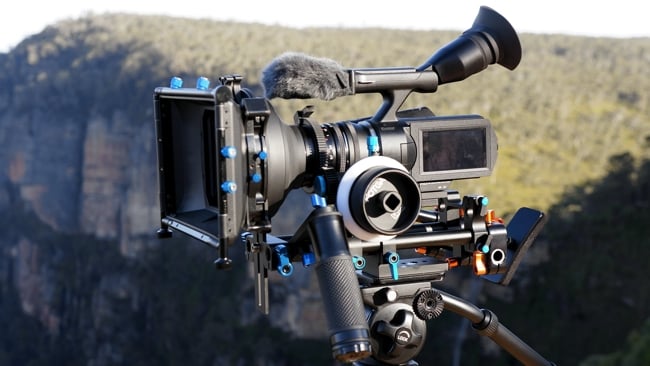
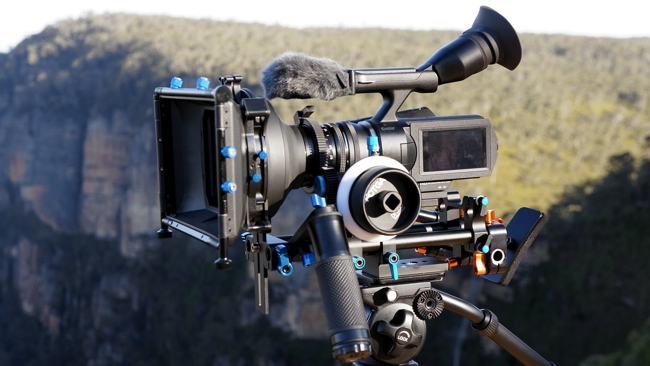 Self-made modular HD camera system
Self-made modular HD camera system
Over the past year, I’ve been assembling a great little modular HD video camera which can be used on a tripod, on your shoulder or stripped down for light weight ‘run-n-gun’ applications. It suits both high end ‘pro-sumer’ as well as ‘professional’ HD video applications and I’d like to now share my results with you. A special project report from RedShark contributor Craig Marshall.
My budget was limited to less than $3K total as beyond that figure, the market opens up to include the BMD Cinema and Digital Bolex cameras. Depending on your audience, both of these have potentially greater merit but may suffer substantially increased operating costs over my solution, especially if you venture into the world of DNG digital negative.
My background is as a video professional. Prior to retirement, my work consisted mostly of broadcast TV commercial production. Among some well known clients, I shot and edited every Toyota commercial in a developing South Pacific country for nearly ten years. Later, I became the Australian National Sales Executive for Fujinon broadcast lenses. Now before you rush off and claim I harbour any bias toward Sony gear, I’ll dispute this by stating that when I used to shoot and edit with broadcast quality Betacam SP equipment, I never really liked the ‘look’ of Sony cameras. Instead, I equipped my independently financed production facility with Ikegami broadcast cameras mated to Sony Betacam SP Recorders and fitted Canon and/or Fujinon ‘broadcast’ ENG lenses. (not the similar but inferior ‘professional’ versions) I sourced all these different brand components from around the world, assembled them together ‘in house’ and fine-tuned them to produce pictures which looked great on the country’s National television broadcasts. Trust me on this, I know a good looking picture when I see one.
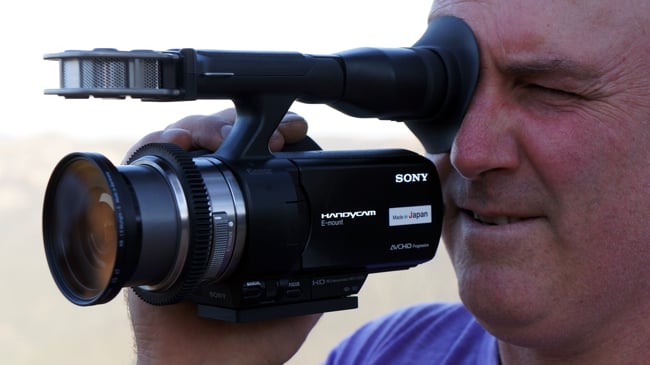
Modular Betacam SP experience
It was this ‘modular’ Betacam SP experience which was the catalyst to create my current HD camera ‘build’. All cameras are a compromise, even the magnificent Arri ‘Alexa’. Try taking one of those on vacation. Over the last two years, there have been some very exciting low budget cameras released including Canon’s 5D Mk11 DSLR which is said to have singlehandedly ‘democratised’ independent film making and probably, for all the wrong reasons. Panasonic released their GH2 DSLR which was subsequently ‘hacked’ to offer specialised ‘tweaks’ and Sony released their F3 and NEX FS100, both sharing a ‘Super 35’ sized CMOS sensor which came with a ‘relatively low’ 2.2 megapixel count but superb HD video imagery.
In September 2011, almost un-noticed in the pro-sumer press, Sony quietly released their NEX VG20 ‘Handycam’ as an upgrade to the very popular but flawed NEX VG10. My modular HD camera build is based around the VG20 and that’s correct, it says ‘Handycam’ right there on the side. I know, this is a word which will cause many professional camera people to move right along but a quick glance through the spec. sheet may be a cause to pause. The VG20 is equipped with the ‘new’ 16.1 megapixel CMOS sensor and EXMOR image processor (same as fitted to the current NEX EA50) so it is a ‘hybrid’ camera. That is, a video camera which also shoots stills as opposed to a DSLR which attempts to shoot video. All the goodies are there in the VG20 including the inevitable ‘touch’ screen. This one flips upside down, then does the ‘hokey-pokey’ to sit right down alongside the camera body facing out. Nice! There’s a proper viewfinder too with a large rubber eyecup, a programmable thumb-wheel, optional focus peaking, optional zebra pattern, a focus expansion switch, optional histogram overlay, manual/auto focus and manual/auto iris. There’s also an ‘auto everything’ panic button should you find yourself in that situation.
VG20
The VG20 sports a large 4 piece spatial on-board microphone with a ‘dead kitten’ blimp and full manual audio control circuits with auxiliary microphone inputs and a headphone output jack. Although the VG20 is equipped with an external stereo microphone input, there are no balanced XLR microphone jacks. Remember, Sony does not advertise the VG20 as a ‘professional’ camera. This lack of XLRs is enough to cause many to complain but few people realise that adding balanced XLRs to any hi-impedance microphone input is simply a matter of purchasing one or more XLR balanced low impedance to unbalanced high impedance adaptors and wiring them to a 3.5 mini plug for mono or stereo. Then you gain the benefit of working with high quality professional microphones and you can use long, low noise ‘balanced’ cable runs. High quality, transformer equipped balanced XLR adapters can be purchased for as little as $15-$20 each on ebay.
The Vg20 also enjoys ‘unlimited’ video recording time to cheap and readily available SD Cards (whoopee, no overheating!) and the camera utilises the newer AVCHD V2.0 video codec which supports 28Mbps frame rates of up to 50/60fps in full ‘Progressive’ 1920 x 1080 as well as Dolby AC3 Stereo or 5.1 Surround audio.
Perhaps one of the reasons this new camera slipped under the ‘popular’ radar was that it did not come equipped with the so called ‘picture profile’ settings like ‘poster’ or ‘sunset’ as found in its little brother, the very popular NEX 5N. My answer to that: get a life and learn to use filters. To be fair, the VG20 does offer a ‘Cinematone’ setting which makes minor chroma and gamma adjustments but in my experience, not much surpasses Schneider’s great ‘digicon’ low contrast filters.
APS-C sensor format
The VG20’s CMOS sensor is APS-C format so is almost exactly the same frame size as the ‘Super 35’ sensor found in the FS100/FS700 and F3 but the pixel count is much, much higher. 16 megapixels ‘squeezes’ down to HD using the EXMOR processing engine pretty wel, in fact much better than can say, 24 megapixels on a full frame sensor be ‘squeezed’ to HD using H.264. Another advantage of the high pixel count is that you have the potential to shoot great RAW still images with just the flip of a switch. This feature can be very useful when you want to shoot a high quality still image time-lapse sequence.
My tests indicate the VG20 is rated about 100-200 ASA/ISO at 0dB gain. Not particularly fast, so I recommend purchasing the ‘body only’ configuration rather than the camera/zoom lens ‘kit’. (you’ll pay around $1100 if you search the usual on-line markets) Although, the 18-200 ‘kit’ zoom is useful, it’s quite ‘slow’ so again, I recommend using some fast prime glass like second-hand Carl Zeiss F1.7 50mm SLR lenses. I recently bought one in excellent condition on Ebay for $185. If you are really on a budget, get one or two of those much under-rated Russian ‘Helios’ M2 screw mount lenses from the old Zenit SLR cameras. They are 58mm primes with a speed of F2.0 wide open and are a ‘clone’ of a famous pre-war Carl Zeiss design. I bought mine on Ebay out of Russia for around $35 each. They focus down to 300mm so they’re good for close-up ‘macro’ shots and for those that like such things, they offer a wonderful ‘bokeh’ too.
One huge advantage of the NEX lens mount is that it uses a very short ‘flange to sensor’ distance so cheap adaptors (eg: $11) are readily available to suit all brands of lens. Note, these simple adapters do not carry any electrical contact information so all lens functions like iris and focus will be manual but if you need more ‘auto’ control, (get over it!)
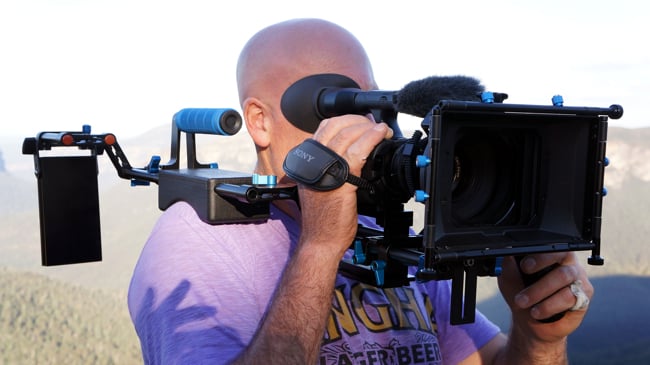
Adapters
Metabones do make excellent NEX adapters which will carry through most ‘auto’ and electrical functions. The APS-C sensor is not as large as a full frame (35mm SLR) sensor so when you fit an SLR lens, there will be a 1.6 ‘crop factor’. This is a huge advantage at the ‘tele’ end where a 600mm full frame telephoto lens suddenly ‘becomes’ a whopping 960 but at the ‘wide’ end, you’ll need to buy a very wide full frame lens indeed and good quality, fast ones can be very expensive. Fortunately, there’s now a great alternative...
Sony recently released a remarkable little wide angle zoom lens which will fit all NEX series cameras from the tiny NEX 5N to presumably, the NEX FS700. It is the SEL 16-50mm zoom which features ‘auto’ focus and OSS (Optical Steady Shot) should you need those niceties. I do not but there is one feature of this new wide angle lens which gets my vote; it has a zoom stepper-motor built in! Set your camera to ‘manual focus’ and you’ll find a slider switch on the lens barrel which will operate the zoom motor. Nice! Now, if you switch the camera over to ‘auto focus', your lens focus ring suddenly becomes a ‘proportional’ zoom controller. Even Nicer! Fast push = fast zoom, slow push = slow zoom. Fit this lens to the VG20 body and you have a great run-n-gun outfit and you’ll look like any other tourist out there and sometimes, blending-in with the mob can be a big advantage.
A lot of lens for the money
Is it as good and as quiet as the proportional zoom on a broadcast ENG lens I hear you ask? No way but it does not cost $15K either. I bought my SEL 16-50mm zoom new, on Ebay for $300, including free shipping from Korea to Australia. (the 35mm full frame equivalent is a useful 25mm to 80mm) This lens has a 40.5mm filter thread so I bought a 40.5-58mm thread adapter as I own a selection of 58 and 67mm ND, UV and Polarising filters. I always fit quality German made Heliopan Skylight 1A filters to all my lenses. Heliopan filters are expensive and there are other good brands about but multi-coated optical glass filters are an essential item for lens protection as well as UV blue cast reduction.
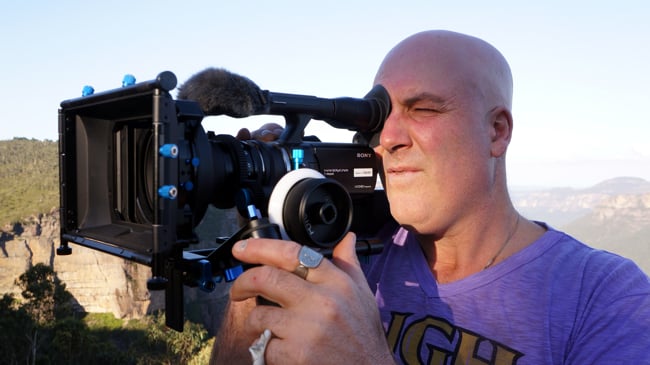
The rig
OK, so now we have a VG20 body and some nice glass, what about a camera rig? Here you can ‘spend the earth’ but fortunately, the DSLR revolution has inspired some Chinese manufacturers to mass produce a lot of fancy items for this expanding market. True, not all Chinese exports offer ‘German build quality’ but by shopping around, bargains can be had. Search ‘DSLR’ on Ebay and you’ll discover an entire world of camera goodies. I bought a set of 300mm long rails for my VG20 and they came with the essential tripod ‘quick disconnect’ mount and geared ‘follow focus’ wheel for around $190. My final choice was for the not-very-pleasant- sounding ‘Fotga DP’ brand but the engineering is of higher quality than many Chinese exports and I’m very happy with it. I also purchased a standard 4x4 matte box for 15mm rails with detachable sun shades. It accepts up to two standard 4” square glass filters, one of which can be rotated through 360 degrees. Mine cost about $145 out of Hong Kong and is made of ABS and Aluminium. No, it is not a ‘Chrosziel’ but it works very well and it didn’t cost more than the camera either. When using prime lenses, a matte box is an ideal accessory as it can be slid out of the way when changing lenses, 4x4 glass filters offer excellent lens protection, it takes all of those great new ‘graded’ colour and ND 4x4 filters now readily available and it looks really classy too! (Should you find yourself in the occasional situation where looking ‘really classy’ is an advantage.)
Rails
With the rails, follow focus and matte box fitted, the VG20 is very stable but becomes a little front heavy so my solution to that problem was twofold. I added a cute ‘pistol’ type hand grip to the front left rail, just in front of the follow focus wheel and set it to about 30 degrees. This serves to hold the camera rock steady as well as offering the opportunity to ‘pull’ focus with just your thumb! This is a really great feature. I also fitted a small shoulder- pad to the rear of the rails so the camera can be gripped using the classic three point ‘triangle’ setup where your elbow forms the triangle and you bend your knees and swivel from the hips to achieve a smooth, steady hand held shot. My second solution was to build up a padded and counter-balanced ‘shoulder’ bracket. This wonderful contraption took some time to sort out but it works very well indeed. It’s quickly attached to the back of the VG20’s rails and consists of an offset ‘Z’ riser, two 400mm long rails with top handle and sliding padded shoulder rest, followed by a second ‘Z’ offset and finally, a lead filled counter-weight. The shoulder pad has a convenient flat top so is the ideal place to fix an SSD HDMI recorder such as the BMD Shuttle.
These optional shoulder support items were independently sourced on Ebay and the result is a magnificent, almost ‘Betacam like’ setup which offers a perfectly balanced shoulder mounted ‘camcorder’ which can be quickly stripped down to suit any application from tripod, to run-n-gun, to shoulder mounted or for studio but the best thing is, the camera and entire ‘modular’ build was achieved for less than my $3K budget.
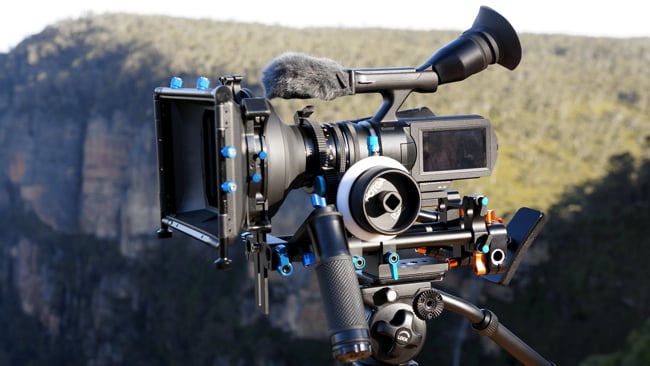
Picture quality
So what about picture quality I hear you ask? Well, it’s pretty darn good for a ’handycam’! Yes, there’s a bit of the usual CMOS sensor rolling shutter ‘slew’ if you pan too fast. You know the old story: “if you need to pan, then don’t!” but there’s virtually none of the 5D like ‘jello-cam’ issues so scorned by the BBC. Sony’s NEX VG20 records 50/60P HD video to SD card at 8 bit 4:2:0 and that’s better than BluRay which currently only supports 50/60interlaced, not Progressive. Should you wish to record even better quality video for a serious colour grade in post or perhaps some green screen work, then the VG20 has an uncompressed and ‘clean’ 8 bit 4:2:2 HDMI output which can be sent to a third party SSD recorder such as the BMD ‘Shuttle’. This is your future upgrade path. (At the time of writing, the much hyped and much more expensive EOS 5D Mk111 DSLR cannot yet achieve this.)
Note that the BMD Shuttle/SSD combo cannot yet record 50/60P, only 50/60i so my solution is recording AVCHD at 50P on the SD card, then transcoding selected takes to 10 bit DNxHD for editing in Lightworks Pro 64 bit.)
Note that although the VG20 is still available, it has been recently superseded by the more expensive NEX VG30. This is virtually only a ‘cosmetic’ upgrade but the ‘30’ does have a zoom rocker control fitted to the hand grip and there is the optional motor driven SEL 18- 200 ‘kit’ zoom lens available, as supplied with the NEX EA50.
Tags: Technology


Comments